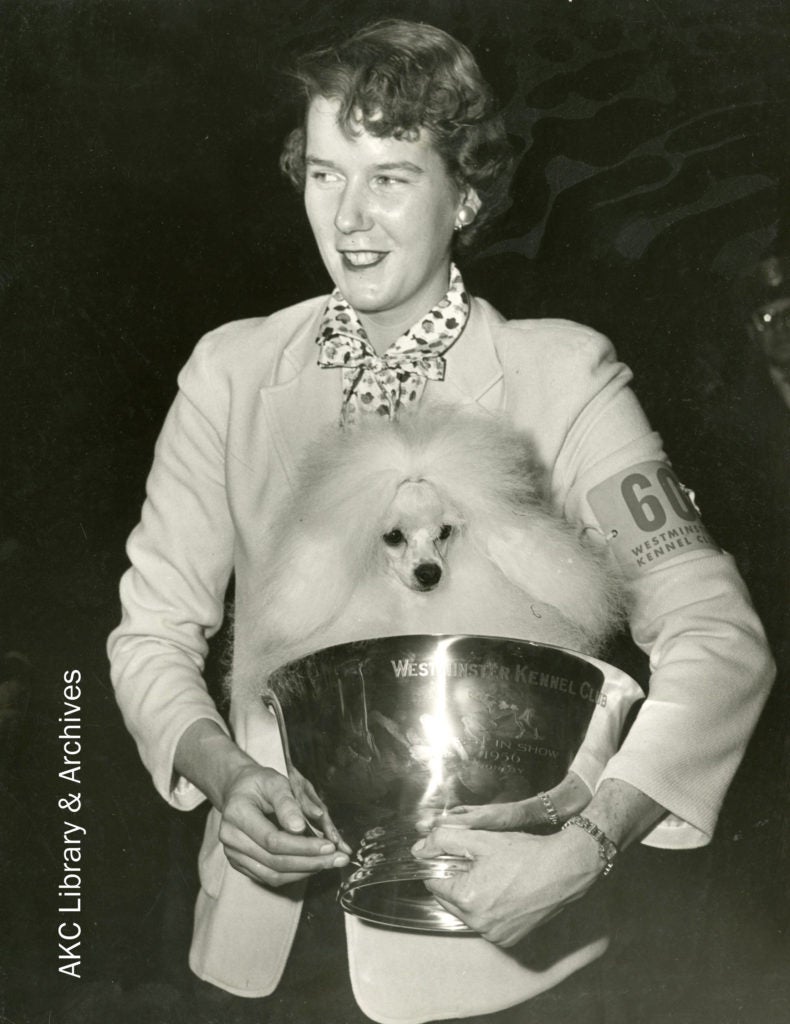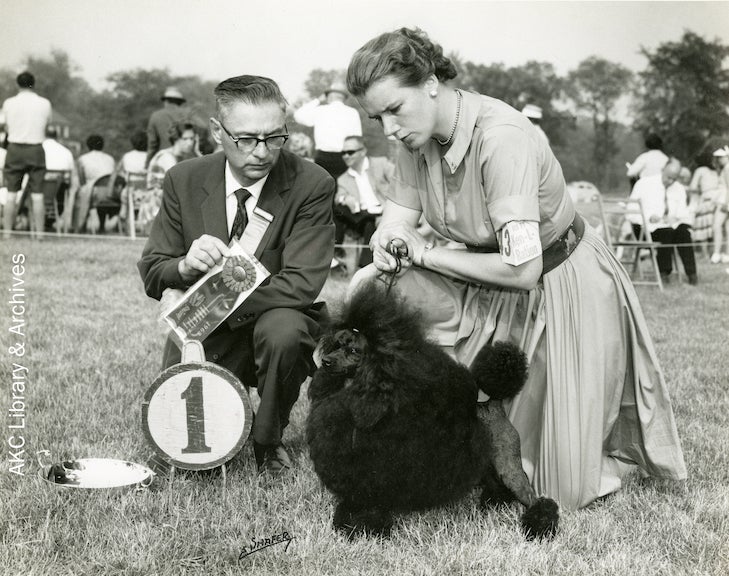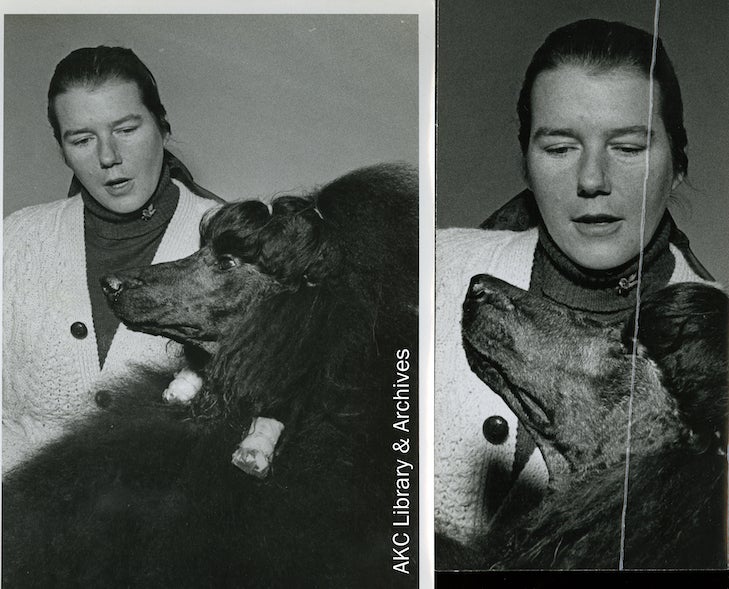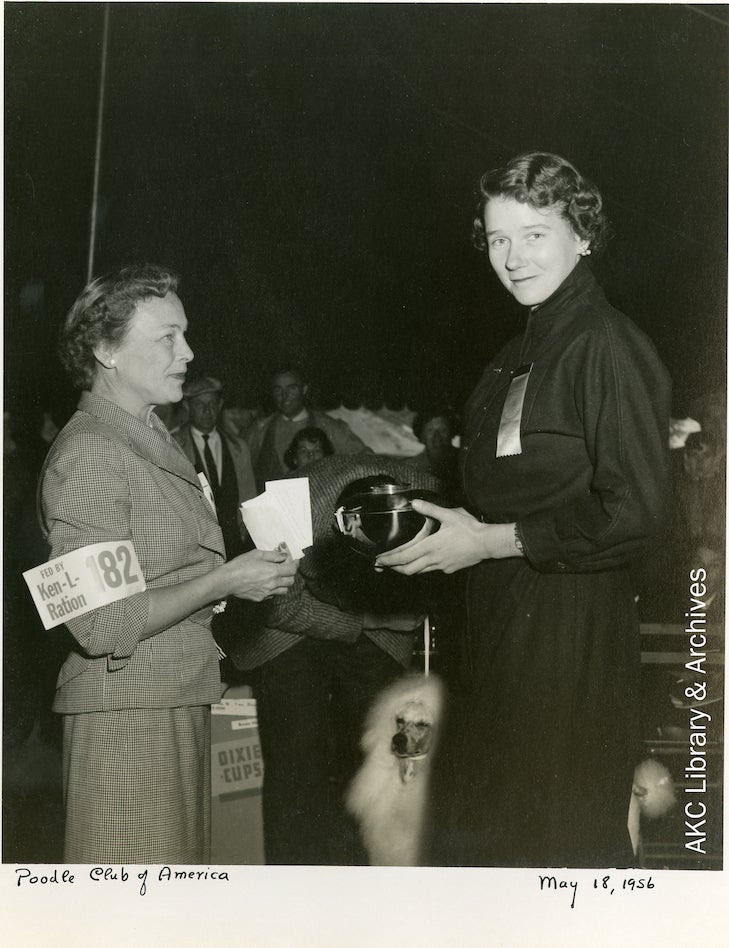An undated video shows Anne Rogers Clark grooming a Poodle
In the not-so-long-ago dog world, there used to be two kinds of fanciers: Those who knew the revered judge Anne Rogers Clark well enough to call her “Annie,” and everyone else, who, in a kind of verbal genuflection, referred to her simply as “Mrs. Clark.”
Today, sadly, there’s the need for a third and ever-expanding category: Those who have no idea who she was at all.
The Iconic Anne Rogers Clark
To employ the word “iconic” to describe Anne Rogers Clark would not be an overstatement. There quite simply has been no one else in the sport of dogs who so thoroughly mastered so many of its facets, from breeding to handling to judging. A deliberate, 6-foot-2 native New Yorker, Clark was ubiquitously described as “imposing” – including in the headline of her 2006 New York Times obituary – earning that adjective as much for her depth of knowledge as her towering height.
Clark had a career punctuated by firsts, so let’s start at the top, with the attendant sound of a glass ceiling shattering: In a sport where most top show dogs were posed and primped alongside pairs of trousers, Clark was the first female professional handler to win Best in Show at Westminster – in 1956 with the Toy Poodle Wilbur White Swan; he, in turn, was the first Toy dog to win the big ribbon at the Garden. Clark then repeated that feat at America’s show of shows in 1959 and 1961 with two black Miniature Poodle bitches: Ch. Fontclair Festoon and Ch. Cappoquin Little Sister, respectively.

Redefining How to Groom a Poodle
As a master presenter of Poodles, Clark experimented with novel approaches to grooming. She was among the first to blow-dry a Poodle’s coat in the direction it would naturally lie in rather than the customary crate-drying with hot air blowing; the resulting coat was free of crimps and curls and gave her the competitive edge – until other handlers started copying her. In 1964, the New York Daily News summed up Clark’s impact by noting that she was to Poodle fanciers “what Dr. Spock is to meticulous mothers.”
Clark’s impact was felt in other breeds, too, often thanks to her friendly rivalry with close friend Jane Kamp – later Forsyth. “… because so many English Cockers country-wide were being shown dripping in hair, we started to trim it off, correctly – not with clippers or razors, but by hand-stripping to smooth the body,” Clark wrote in one of her columns. That “trimming war” basically revolutionized how the breed was presented and has stayed the standard to this very day.

A Family Affair
Though she also bred English Cockers, Norfolk Terriers and Whippets, Clark was best known for her Poodles. In 2002, Clark won her final Best in Show at the Garden, but this time as a breeder while watching from the stands as Miniature Poodle Ch. Surrey Spice Girl took top honors, piloted by her co-breeder and Clark’s protégé, Kaz Hosaka, who is still breeding and showing today.
Dogs were a family affair for Clark, whose mother, Olga Hone Rogers, bred English Cocker Spaniels and Poodles of all three varieties. Clark – then known as Anne Hone Rogers – started showing her mother’s dogs at around age 7 or 8, and was a professional handler by the time she was in high school.
When her family lost its wealth during the stock-market crash, Olga Hone Rogers launched the dog department at Abercrombie & Fitch, eventually leaving the tony store to establish her own grooming shop, Dogs Inc. Clark helped out there, scissoring spaniels and sculpting poodles in the bottom floor of a Manhattan brownstone, sizzling during summers when the fans were little help against the relentless heat outside and the hot air blowers inside. Despite the hard work, Clark soon concluded that the dog’s life would be hers, turning down a full scholarship to veterinary school.

For the Love of Judging
As a judge, Clark was nothing short of revered, one of only two dozen licensed to adjudicate all 165 then-recognized AKC breeds. She explained her “infatuation” with judging by likening it to prospecting for gold or gemstones in the hopes of the next “great one.” “It’s to get the feeling of the hairs raising on my arms, and the feeling of discovery that runs through me as an electric current,” she wrote in her popular “Annie On … Dogs!” column in the now-shuttered Dogs in Review magazine.
Indelibly associated with Westminster – along with her husband James Clark, she provided on-air commentary during the show for two decades, until the mid-’80s – Clark judged the show a record 23 times. She was also the only person in the show’s long history to judge all seven groups as well as Best in Show, appearing on the famous green carpet with a frequency that eventually permeated the public consciousness: In a 2003 interview with USA Today, Clark recalled flying home from a long weekend after judging an Oregon dog show when the flight attended pointed and gasped, “Westminster!” “Like it was my middle name,” Clark deadpanned.

A Worldwide Career
Of course, Clark had a career that reached well beyond that show of shows – judging all over the globe, presiding over both the Poodle Club of America and the English Cocker Spaniel Club of America, and authoring the exhaustively researched International Encyclopedia of Dogs.
Despite her worldwide reputation, Clark was characteristically self-effacing, admitting that her feet were so large she tried to hide them behind the photographer’s sign when posing for win photos, and calling herself “the slowest judge AKC ever dealt with!” Until, that is, she invested in an obscure book on how to judge dairy cattle, which she credited with helping her learn how to systemically sort a ring full of dogs.
Anne Rogers Clark has been gone for more than a decade, and the list of those who knew her – by any name – grows ever shorter, as new generations come up and memories fade. But the inroads that she made, and the wisdom she imparted – including her golden rule, “make the first cut on type, and then reward the soundest of the typical specimens” – is still passed on to new judges, even if they don’t know its provenance.
In that way, at least, Mrs. Clark is still among us.
Craving more AKC History? Follow the AKC Library & Archives on Instagram.

